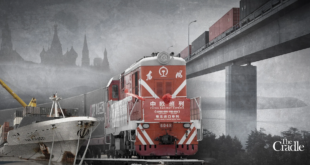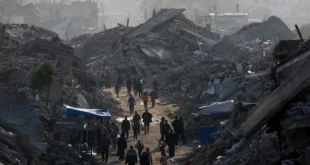Rights organisations are dismayed by the Greek government’s decision to close two model facilities on Lesbos – whose exemplary conditions differed markedly from the infamous, now destroyed, Moria camp.
The Greek government’s sudden decision to close two small exemplary refugee facilities on the island of Lesbos has sparked protests from their communities and drawn a pan-European response in their support.
Pipka, a self-organized facility close to the island’s airport, which housed about 100 vulnerable residents, funded by public donations, is expected to be evacuated this week, even though its evacuation was initially planned to take place by October 31.
It has also been announced that Kara Tepe, a municipal-run facility handling just under 1,000 families and vulnerable cases, is to be emptied by December 31.
Humanitarian workers at both structures have raised concerns about the future of the residents, who include some highly vulnerable individuals and families. Concerns have also been expressed about the conditions into which future arrivals with similar profiles will be asked to live.
Just a week before Pikpa was expected to be evacuated, its residents told a press conference that, “the solution lies not in the closure of Pikpa but in creating more shelters like it”.
At the same time, the first rainfall on Lesbos has shown why asylum seekers living in “Moria 2.0” told BIRN that the new camp set up by the Greek government to house all asylum seekers on the island from now on was even worse than the original Moria, which burned down last month.
An unexpected evacuation order
Since the refugee crisis first hit Greece years ago, Lesbos has received the biggest number of more than 1 million sea arrivals to the Aegean islands.
In July, a report by the UN’s refugee arm, UNHCR, said the island this year had received 4,108 out of 8,400 of the refugees and migrants who reached them, or 49 per cent of them.
The island’s Moria camp, which had the dubious distinction of becoming perhaps the most notorious refugee facility in Europe, last February hosted a population that was no less than seven times its initial capacity – 22,000 instead of 2,880. It burnt down on September 9.
Neither Pikpa nor Kara Tepe, on the other hand, exceeded their capacities, and both ensured humane conditions for their residents.
Pikpa, an open, self-organised site, which took in more than 30,000 people since 2012, was home to just 99 on the day of its evacuation. Of that number, 21 were unaccompanied minors of high vulnerability, meaning girls younger than 17 and boys younger than 12.
The rest were people with heightened disabilities, such as torture and ill-treatment survivors and cancer patients.
In 2016, one of Pipka’s co-founders, Efi Latsoudi, was awarded the Nansen Refugee Award by the UN’s refugee arm, UNHCR, for ensuring a safe haven for many people in need at the peak of the refugee crisis.
Talking to the local media outlet Sto Nisi on September 23, Greece’s Minister of Migration and Asylum, Notis Mitarachi, first said it would be evacuated by October 31, with a view to satisfying the “constant demand of local society and the Hoteliers Union”.
The facility would be given back to the Ministry of Labour, to which it belonged, to function either as a children’s camp or as “anything else decided in the interests of the local society”.
The evacuation date was then brought forward to October 15, and, as Latsoudi told BIRN, they were then notified that it would close by October 12.
The residents would move to “Moria 2.0”, the new camp created for victims of the fire at the original Moria camp.
“We tried [in vain] to offer alternatives, so we could at least house our people in humane conditions until they could be moved to the mainland,” Latsoudi told BIRN.
The transfer of some unaccompanied minors to facilities on the mainland was since agreed, but as COVID-19 health measures saw a number of them put under lockdown, their transfer can’t take place.
Other unaccompanied minors are expected to move to the new camp, which until now did not host minors without family members. It also lacks a “safe zone” – a separated area where minors without families can live under supervision, protected from the camp’s other inmates.
“The ministry seems to consider the new camp appropriate for everyone,” Latsoudi said. Residents’ testimonies suggest this is far from reality.
‘Moria 2.0’ fails to live up to promises
The fire at the original Moria camp, as BIRN reported from the ground, left about 12, 500 asylum seekers living in the open.
They endured grim conditions, sleeping rough for a week on a coastal road. Despite that, they mostly hesitated to enter the new camp that was rapidly being prepared in a former army shooting range, fearing it would be a “closed” facility that they could not leave.
To persuade them to enter, the Greek authorities promised them access to food, showers and electricity, adding that Skype interviews for asylum applications would begin again on September 21 – before which asylum seekers would need to register in the new camp.
One month after the new camp was set up, the authorities’ promises are far from reality. Asylum interviews, for example, are not to begin until October 10, two weeks after the initially planned date.
Residents of Moria 2 also told BIRN that they only got food once a day, of poor quality, so most families prefer to cook for themselves. They can exit the camp on weekdays and on Saturdays to buy groceries from nearby supermarkets, although they have to wait in queues for hours on their return.
The electricity supply is limited to specific areas of the camp, and there are still no showers.
Zabi, 28, an asylum seeker from Afghanistan, told BIRN he had caught a cold from showering in the open. Women reportedly bathe their children in the nearby sea.
At the same time, the lack of toilets forces some residents to walk to a nearby town and use the toilets in the town cafés. Some residents have expressed worries about lead poisoning, since a part of the field where the new camp lies used to be an army shooting range.
The first rain of the season in Lesbos has meanwhile flooded tents with water and even mud. The pictures that some camp residents shared with BIRN showed tents in no condition to house anyone.
Confusion over why it was targeted
The municipality of Mytilene gave the space for Pikpa to Lesvos Solidarity, the NGO that still runs it, in 2012. Three years later, in 2015, the Ministry of Labour to which the space also belongs approved its use for temporarily accommodating refugees and migrants.
In support of its decision to evacuate Pikpa, however, the government ha since started referring to various factors “occupying” the site.
Lesvos Solidarity argues that no reference to “occupation” should be made, as Pikpa’s work was always coordinated with the authorities.
Transfers there of unaccompanied minors only took place on the orders of the local district attorney, who by law has custody of unaccompanied minors; transfers of vulnerable cases needed a written referral by the UNHCR. On top of this, Pikpa provided the authorities with a list of the accommodated beneficiaries every week.
Christina Psarra, director of Médecins Sans Frontières, MSF, told BIRN that the point was not only to reopen Pikpa.
“The goal does not lie solely in keeping Pikpa open but in having [other] open accommodation facilities that offer a dignified living and can function as alternative forms of accommodation, compared to the example of Moria,” she said.
MSF had been directing cases of high vulnerability to Pipka, people who, Psarra added, “would in no way recover if they had stayed in Moria”. Besides, she noted that state officials had often visited Pikpa.
Closure, she added, looked like “an effort to target a facility that during all these years not only satisfied needs – but satisfied needs that should normally be addressed by the state”.
Government and UNHCR trade blame for mishaps
In the wake of the announced closure of Pikpa, the UNHCR urged the Greek government to make sure “initiatives are in place to provide protection and address the specific needs of particularly vulnerable refugees”, while also voicing alarm over the conditions in “Moria 2.0”.
In an unprecedented dispute, the Ministry of Migration and Asylum responded with a press release blaming the flooded tents at “Moria 2.0” on the UNHCR, stating that the tents “were provided as appropriate by UNHCR and bear its logo”, and urging the UN body to speed up the infrastructure work it is responsible for.
The war of words has a context. UNHCR has lately urged the Greek government to investigate reported pushbacks taking place on its land and sea borders, more recently on August 21, 2020, and June 12.
The migration ministry has come under growing pressure after a series of well-documented media reports on pushbacks – but maintains its denial that such practices take place.
Talking to local media Sto Nisi on September 21, migration minister Mitarachi said the Kara Tepe facility would also be evacuated by December 31. He described a decision “already taken”.
The municipal-run facility that started operating in 2015, in a space that previously served as a driving school park, likes just a few minutes’ walk from “Moria 2.0”, and hosts vulnerable asylum seekers and families, among them people with serious health problems.
Compared to Moria camp, or “Moria 2.0”, the conditions might be deemed almost hotel-like.
Residents have electricity, heating, air-conditioning, running water and showers. Compared also to the atmosphere of insecurity framing life in Moria, Kara Tepe is known for its safe environment and lack of tensions among its residents.
Closures condemned by international watchdogs
On October 5, the international rights watchdog Amnesty International called on Greece to “revoke the decision to close PIKPA, let the organization operate freely, protect its around 100 residents, and ensure and promote open and safe spaces for asylum-seekers and refugees in Greece”.
One week earlier, on September 30, more than 160 Greek and international organisations, academics and other actors from all over Europe signed a letter also urging the Greek authorities “to revoke decisions to close dignified alternatives in accommodating refugees οn Lesbos”.
Actionaid, one of the organisations that signed the open letter, maintained a presence on Lesbos between 2015 and 2017, at the peak of the crisis.
Maria Mourtzaki, its policy coordinator, told BIRN that too little had changed over the years.
“Since 2015 we find ourselves in a situation that – although its basic features, when it comes to the treatment of asylum seekers, remain as they were – is dynamic in a unique way. Reality changes all the time, but everything remains the same,” she said.
“After the destruction of Moria camp, Pikpa and Kara Tepe kept offering a solution to the most vulnerable, as they have been doing for some time, and the first announcements for their closure brought concerns and even bigger insecurity for the future,” she added.
“The common belief of people in the field, and not only them, is that the solidarity which was materialized in these two shelters should not be punished,” she concluded.
 Eurasia Press & News
Eurasia Press & News



